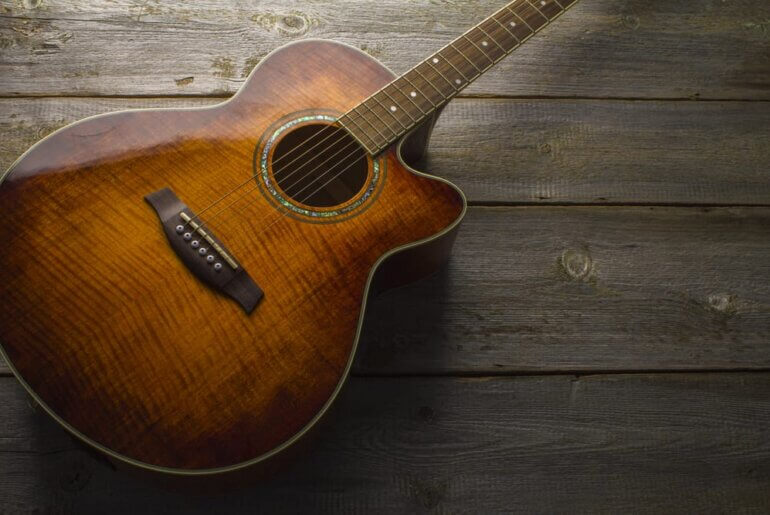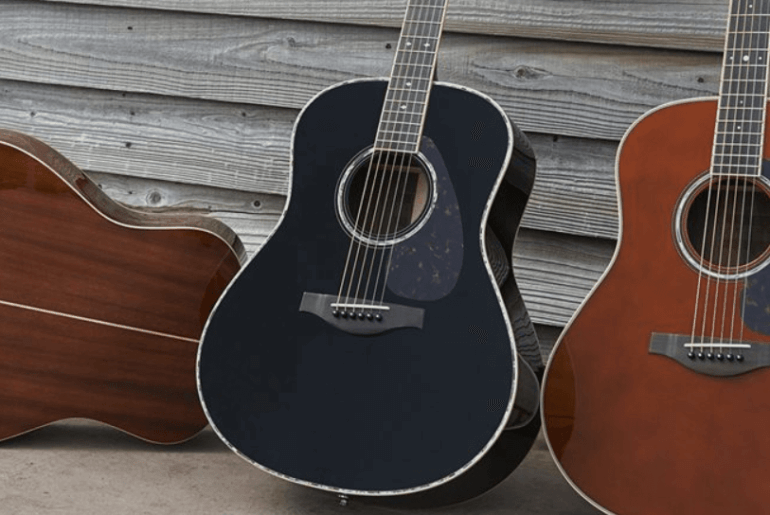Reading about varied types of Acoustic Guitars can amuse people for two reasons. One: if you aren’t a Guitar player, you do not know about acoustic guitar types. Two: you do not know how they are classified unless you’ve ever enquired or got them on your shopping cart. The acoustic guitar is an instrument that has a long history. The instrument has been a fixture in Western music for more than a century.
Legendary studio recordings have ensured their presence in them. Despite this long history of the instrument, it is hard for someone to notice the subtle differences that separate one type from the other. Some of the typical names that one comes across while looking for an acoustic guitar are Dreadnought, Parlor, Auditorium, concert, etc.
These names aren’t merely market names. In fact, they have established conventions for specific flat-top, steel-string acoustic guitar body shapes and sizes. Names, shapes, and sizes of acoustic guitar are all useful in determining three things:
- Whether you want to buy a larger or a smaller one?
- Do you wish to have a louder one or a softer one?
- Which guitar suits your fingerpicking style the most?
Most of these styles include a cutaway i.e. either rounded (Venetian) or sharp (Florentine). Having given a brief to you about the types, it’s time now to check one by one, each one out.
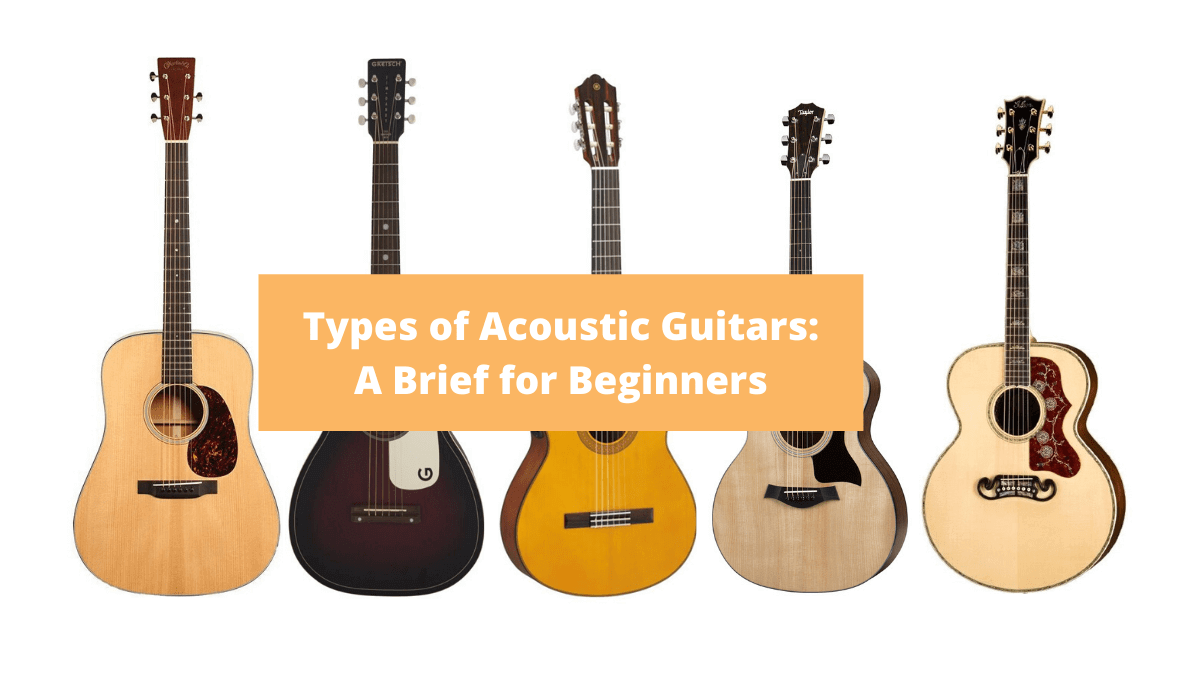
What Are Different Types of Acoustic Guitars?
As already mentioned, there are various types of acoustic guitars. And, it is important to have a brief idea of each of them to make the right pick.
Dreadnought Guitar:
Known for its larger size and bold sound, Dreadnought was first manufactured in 1916. The reason why Dreadnought produces bold sound is because of having broad square shoulders and a larger internal cavity. The shape of a Guitar determines the type of tone and an overall sound that it produces. Dreadnought produces a very tight sound that accentuates the bass frequencies and gives a strong midrange with cutting highs. A dreadnought body shape is a preferred tool in the Bluegrass flat picker’s arsenal.
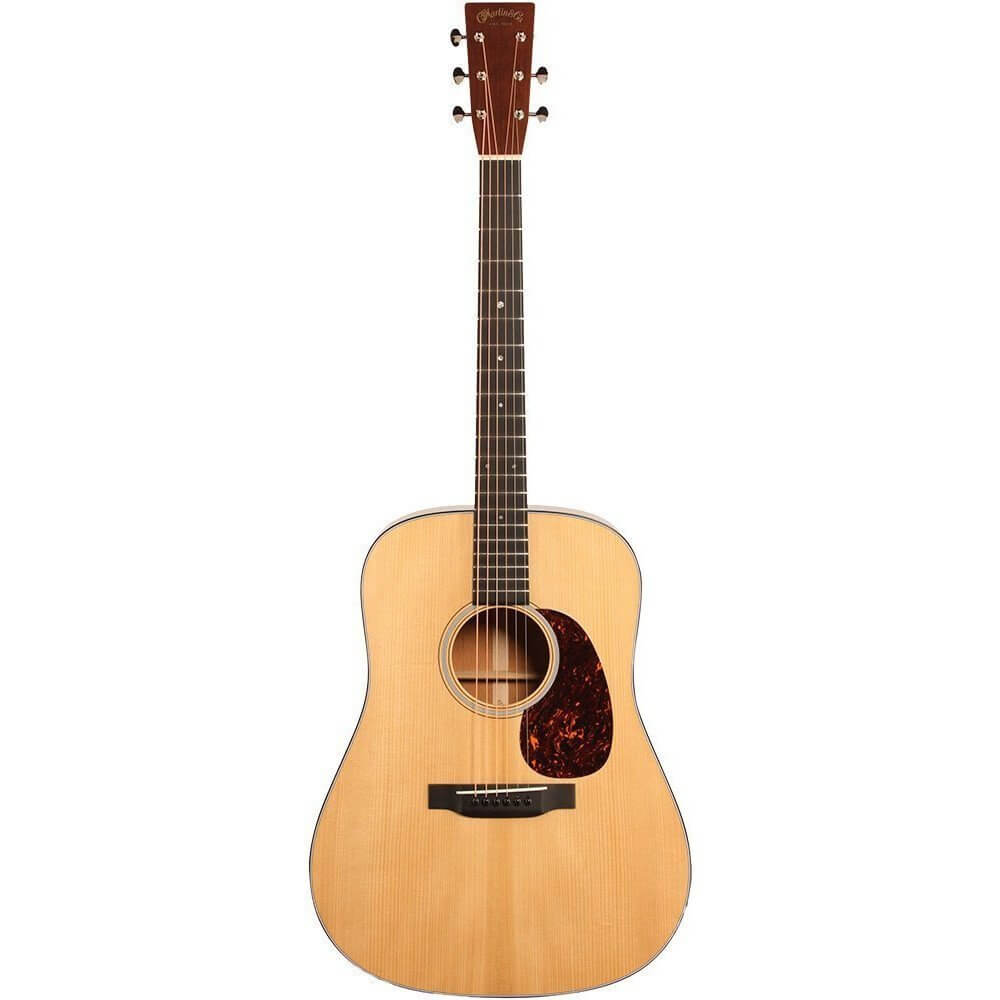
The Dreadnaught was produced by C.F. Martin who named this shape HMS Dreadnaught. Since then, the Dreadnought remains a choice of professional guitar players all over the world.
Notable Players who have played Dreadnought:
Folk artists like the Martin have chosen Dreadnought as their go-to instrument of choice. Joni Mitchell had effectively used Martin Dreadnoughts to play sweet Folk music, Jazz, etc. Modern examples include Dave Matthews and Tim Reynolds in their album “Live at Luther College.” Dreadnoughts are not known to be limited to Bluegrass or Country music. They are widely used for every genre where players prefer a strong, cutting, and bold balanced sound.
Pros and Cons of a Dreadnought:
Pros
- If there is one acoustic guitar that strikes the evenest balance between volume, size, and ease of playing, it is Dreadnought. It is also the most preferred instrument that every big-named player during live shows and/or recordings. Loved by beginners and chosen by experts, it is one of the most popular among different types of acoustic guitars.
- Dreadnought is the first thing non-players imagine when they really think of purchasing an acoustic guitar. It’s one of the most versatile acoustic guitars you can ever pick up. Dreadnought is not versatile because it’s available in various shapes. It is versatile because it has a variety of musical settings and a wide range of genres can be played on it. Anywhere from rock to folk, indie to punk.
Cons
- Dreadnought guitars have a relatively narrow neck which may not be ideal for people with fat fingers. If you are a player with shorter arms, this style of a guitar can be quite uncomfortable. Chances are you might get your arms to dig into the body of the guitar when you reach around for it to strum.
- Dreadnought guitar comes with a relatively bulky box container which can make it hard for a beginner to hold the body of the guitar. If you are still a newbie, then handling a Dreadnought is probably going to be your first problem. You might have trouble handling it especially if you are going to the fretboard and try to tip it.
Notable Models of Dreadnought:
Martin offers some of the greatest acoustic Guitars the world has seen so far. A great yardstick against which other dreadnoughts can be measured is the Songwriter Deluxe.
It is named after the bird which Gibson best felt described its unique qualities. The Hummingbird is one of those unique things that you’d ever find in the acoustic guitar industry. It offers you to have a natural wood finish like those seen in Gibson’s now famous electric guitars like the Les Paul and ES-335.
Parlor Guitars:
They are among the smaller bodies available in acoustic guitars which have started to appeal to people. Mostly Solo artists prefer Parlor Guitar more because of their body shape, which is light and yet offers a balanced tonal spectrum. They carry them to their live shows because they are smaller and easier to travel with as well! Parlor Guitars are another type of acoustic Guitars that is invented by the CF Martin guitar house.
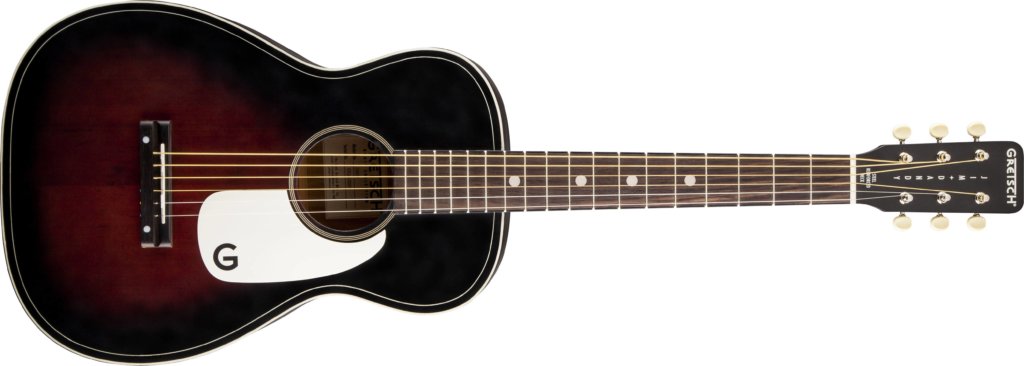
The guitar’s neck typically joins the body around the 12th fret. where the body meets the neck joint – will usually be slightly more sloped than you’d see in a classic dreadnought acoustic. This means that the base of the body will also be narrower in comparison with larger sized guitars.
All of these make more comfortable and less physically intrusive playing experience. Another benefit of this is the portability of Parlor guitars. Their relatively smaller form enables themselves well to being slung in a case and carted off to gigs with less hassle than. Parlor acoustics are typically favored by players of more low-key, less brash musical styles like folk and indie.
Pros and Cons of Parlor Guitars:
Pros
- Because they are smaller in size, they can be taken to places where bigger ones cannot be taken to. Especially if you are not a fan of carrying your guitar everywhere, parlor guitars are a gift for you.
Cons
- They have lesser frets than the regular Dreadnaughts. So if you are a player who loves to play in-depth music, Parlor might not be a recommendation for you.
Notable Players who played Parlor Guitars:
The late great “King of the Delta Blues” Robert Johnson used his bottleneck slide in conjunction with his Parlor guitar to change the music world.
Ian Anderson of Jethro Tull employed Parlor guitars for his Irish inflected acoustic work. This work set across a fantastic example in front of the world. It displayed how well the tonal properties of the body shape allows the guitar to fit in with a full band. Anderson could make the Parlor guitar speak or wail.
Notable models of Parlor Guitars:
A great example of a modern Parlor guitar is the Farida M26-E. Not only does it offer the classic smaller body size, but also a superb choice of tonewoods. For a Parlor guitar to offer an on-board electronics system is abnormal. This makes the guitar just as comfortable to play at home in a small pub gig as it is in a stadium.
Jumbo Guitars:
After seeing the standard of acoustic guitars, let’s dive into the big boy of the acoustic guitar world. Introduced by Gibson in 1937, the Jumbo shape if more rounded in its shoulders and bottom. The shape provides the largest sound cavity compared to any other. The benefit of making this shape larger and wider is the output of Volume. Whether you are strumming hard or softly fingerpicking, Jumbo gets you the most volume for your money, guaranteed. Pick-ups and pre-amps are known to provide any volume you want.

In such a world if you are an acoustic player who is in search of a loud guitar, the jumbo is your instrument. The larger cavity produces a more open type of sound that can really accentuate the bass frequencies. The Tonal terminology of Jumbo can be difficult to speak about. Maybe you’re a loud singer who needs an instrument that can compete with your belting out mega vocals. Or you are in a band that just tends to play out loud. Jumbo offers you a solution to both.
These big and boomy guitars are often also known by the name,” the standard cowboy guitars.” Up to 17 inches at the lower bout, Jumbo guitars project loudly and resonate deeply. This height provides a huge projection and a high volume ceiling. Technically this means that it can produce louder sounds without distorting. You will often find more elaborate decoration on Jumbos compared to other styles. There’d be specially-designed bridges, fretboard inlays, and headstocks. When it comes to tone of the guitar, Jumbo’s is generally very well-balanced with a big low-end boom. Jumbos are particularly popular with country players and were a favorite of Elvis Presley, who used this style throughout his career.
Pros and Cons of Jumbo Guitars:
Pros
- Jumbo Guitars have a very strong volume output and resonance because of which they are favored by some of the most celebrated guitarists.
Cons
- Some guitarist finds it hard to stably play Jumbo Guitars and prefer a rather lower sound-producing instrument.
- Because of its impression, Jumbo Guitars are not recommended for beginner or intermediate level players.
Notable players who played Jumbo Guitars:
- Bob Dylan is one of the most widely known singer-songwriters who used Jumbo Guitar to compliment his vocals.
- Elvis, Emmylou Harris, George Harrison also used Jumbo Guitars to accompany them along with their singing.
- You can also see jumbo-sized acoustics in the hands of Noel Gallagher.
- Because of its shape and the perfect balance between playing and comfort Jumbo Guitar was often seen on the lap of Eric Clapton.
Notable models of Jumbo Guitars:
- The first every jumbo acoustic was released by Gibson under the name Gibson Super Jumbo. Players, particularly rhythm players, took to it on account of its deep bass sound which provided the perfect complement.
- While Gibson is the creators of the original jumbo-sized acoustics, Epiphone also does a range of Jumbo acoustics. Tones that are perfect for players looking to dip their toes in the water. The Epiphone EJ200CE is identical in dimensions and appearance and cost to call itself a Jumbo Guitar.
Auditorium Guitars:
It is difficult for a novice to tell a difference between Dreadnought and Auditorium Guitars. Both of them are designed by CF Martin. But the latter offers are much tighter waist and tonal characteristics. Physically, the Auditorium guitar literally fits over your leg much more snug, due to its refined waist. The inner curves of the guitar are defined more inward. This inwardness decreases the amount of inner cavity the guitar shape actually has. Auditorium Guitars are more comfortable for players who like the instrument to firmly sit on their leg without any tendency to slide around. A tighter waist provides certain tonal differences with Dreadnought.

There is an “in-between” status given to the Auditorium style. Folk players who sought the ability to jump between intricate picking use Auditorium Guitar. This enables them to keep up the low end when digging into chords.
Dreadnought versus Auditorium:
- A Dreadnought offers a strong Bass and Mid-Range frequency spectrum. Whilst the Auditorium tends to smoothen the EQ curve. This smoothing offers a balanced range with the same booming volume that the Dreadnought offers.
- Some guitar aficionados claim that Auditorium models sound great using lighter string gauges compared to Dreadnoughts. However, the point worth considering is, any competent guitar technician can set up an instrument to sound great regardless of string gauge. But the convention is still there, so some players agree with this. If you play with a lighter touch, the Auditorium shape may be preferable to you.
- The Auditorium has a more pronounced waist. Something that some players prefer over the Dreadnought. There’s a deeper cut in Auditorium, against the knee to lower the guitar, and a deep cut on top for easier, more accessible arm clearance. On an end-to-end or side-to-side measurement, Auditoriums tend to be near or the same as a Dreadnought.
- The Auditorium Guitars have slightly more subdued bass and balance. This makes them ideal for solo performers who have the sonic space. Especially players who are known for the more gentle and intricate playing that stands out.
- It’s best to play both types of guitars with your own hands and experience the difference yourself. Doesn’t matter which one you lean towards, you can learn to handle both. Because you will feel and hear the difference when one would be compared to the other. Each player is unique and you should always choose what feels and sounds best to you!
Notable Players who played Auditorium Guitars:
The most famous guitarist that uses the Auditorium shape is Eric Clapton. He uses his signature model. If you’ve ever heard an unplugged album, you are already familiar with the beautiful tones that he evokes. Clapton runs his auditorium guitar through the paces with heavy strumming and subtle fingerpicking. Bluesy lead licks that show the versatility that can be commanded with this shape of acoustic.
Notable models of Auditorium Guitars:
Martin’s creation, the 000-shape guitar is almost the perfect halfway house for an Auditorium Guitar. Its classic hourglass figure makes it seat comfortably on the knee, endearing it to players of folk and other fingerpicking-heavy styles of music.
Grand Auditorium Guitars:
As the name suggests, the Grand Auditorium is a larger version of the Auditorium style. Taylor Guitars is the company that defined and produced the Grand Auditorium. Auditorium Guitars are a wonderful example of what a competitive market can create. It is due to the competition between Martin and Gibson acoustic guitar body shapes that created the shape of this guitar. Grand Auditorium includes their qualities and apart from it, it also includes all the mainstays we have come to know and love. Grand Auditorium Guitars are known for the high quality of “plugged in” tone.
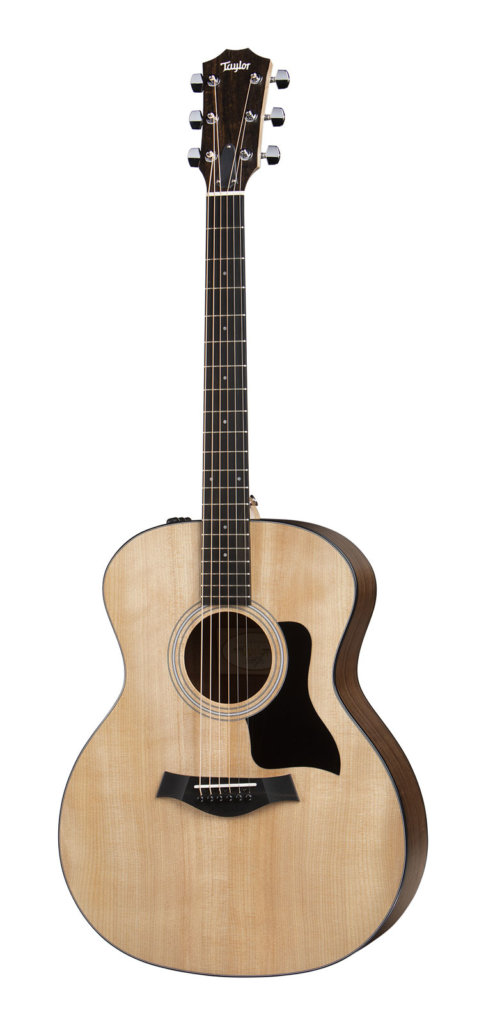
These guitars are similar to a larger proportioned Dreadnought. They possess a larger body shape and a purer unadulterated volume. Grand Auditorium is a top choice for musicians who want a single guitar to travel with. The tone of this guitar is great for strumming and/or picking. Grand Auditorium performs well on stage as well as in the studio. GA is also very popular with songwriters as they can do more with this single than with several instruments. Few things to consider when choosing the Grand Auditorium guitar are:
- The GA produces a bigger and clearer sound when compared with other guitars.
- It is easier to hold the guitar due to a smaller waist.
- The guitar fits well on the knee when performed sitting.
- The GA has a great balance in writing, performing or recording.
- The guitar is well-defined mid, low and treble notes.
- The GA uses the most standard fret scale length.
Pros and Cons of Grand Auditorium Guitars:
Pros
- Players wanting a multi-purpose guitar choose Grand Auditorium for its versatility.
- Grand Auditorium’s style suits all genres of music and styles of playing.
- Also, very good for those with a lighter touch. With a pickup/preamp system, they are also one of the nicest sounding guitar styles plugged in.
Cons
- The most aggressive strummers may find the lower volume ceiling hard to work with Grand Auditorium.
Notable players who played Grand Auditorium Guitars:
Designed to be the greatest all-rounder, the Grand Auditorium shape has the perfect blend. Its size, shape, volume, comfort, and its modern-day incarnation has seen the likes of the Taylor Swift. People forget that even before mega-stardom, Taylor was a respected country artist. And it was on a Taylor Grand Auditorium that she plied her trade.
A good earful of what the Grand Auditorium guitar shape has to offer is heard by hearing Taylor Swift. During her formative years as a famous country artist, she used the Grand Auditorium exclusively. Her songwriting and vocals type suited the Grand Auditorium Guitars, the most.
Notable models of Grand Auditorium Guitars:
The GS Mini and Big Baby are examples of Taylor leading the way in acoustic guitar innovation.
Classical Guitars:
The misconception that people carry along with this name is that they are Nylon stringed guitar. No! That is not the case. These guitars can be played with steel strings too. If you are a finger picker who enjoys the soft sounds, Classical Guitar will most likely suit you. Known for producing the traditional European orchestral music, Classical guitar is definitely worth a shot. Classical guitars with Nylon strings are popular for playing traditional Classical genres and Flamenco.
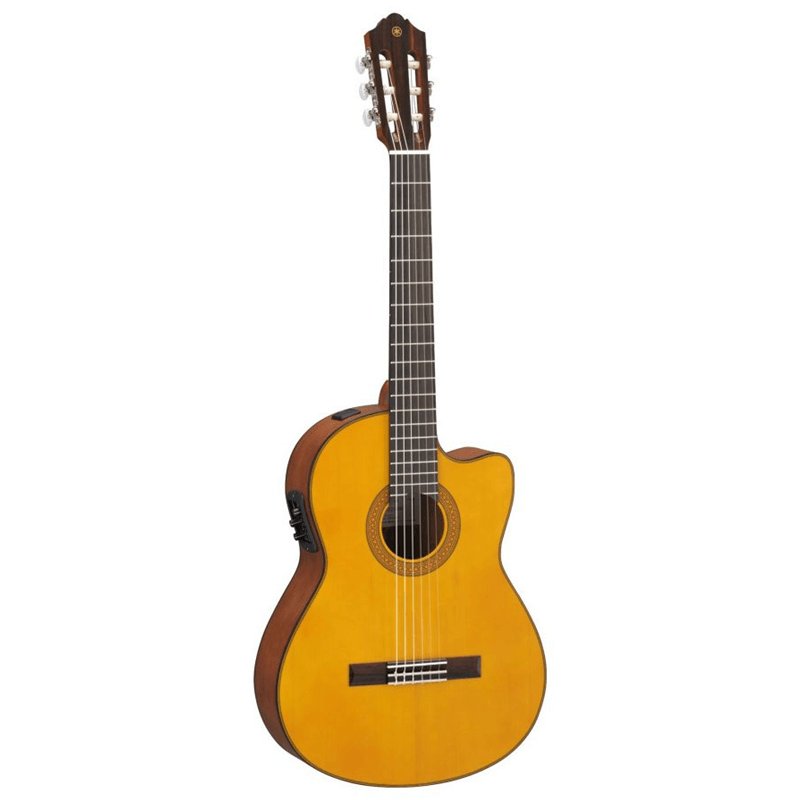
Classical guitars are easily identified by their open slotted tuners. These uses cam instead of standard tuner posts. The tuner knobs recede perpendicular from the back of the headstock. This is abnormal to the parallel movement with the sides of the headstock. Classical guitars are Spanish in origin, hence the typical Flamenco style associated with them. They are usually smaller than their steel-strung counterparts which enables them very particular playing style adopted by the ‘real’ players. The playing style sees headstock pointing to the sky, body wedged in between knee and chest.
Pros and Cons of Classical Guitars:
Pros
- This is an easy one for classical guitarists! Any player who wants the softer, balanced sound of nylon strings, may choose Classical Guitars.
- For Spanish, fingerstyle and Flamenco players Classical Guitar is a gift. These guitars are also a good choice for beginners, as the strings are easier on the fingers.
Cons
- Flat-pickers and strummers won’t enjoy the experience of a classical guitar. The traditional steel-string songs will always sound a little weird played with nylon strings.
- Players with small hands may struggle to make chords due to the larger fretboard. Although if this is the case, several ¾ and½ sized classical guitars are available.
Notable players of Classical Guitars:
From Andres Segovia to Christopher Parkening, you’ve heard this soft tone getting used in all sorts of genres.
These tones can easily become bright when strummers, like the great Willie Nelson, use it. His famous guitar has taken a beating over the years and yet keeps on ticking. An interesting note about Willie’s guitar is that: He didn’t literally pick through the top of his guitar and removed the wood by strumming.
Notable models of Classical Guitars:
A great example of classical guitars is the Merida Trajan range. Playing one of these guitars will perhaps shock you. If a cheaper version is all you’ve seen of the nylon-string world then this one is worth checking out.
The Conclusion:
I hope that this rundown of some of the standard types of acoustic guitars benefits you. There are so many types and shapes of acoustic guitars that can also be investigated. Any player can find the perfect match for their playing style and vocal range. While choosing an acoustic guitar for you, take your time in the quest. There are so many variables to be considered. From the visual appeal to their volume, from the tone to their size and shape. But the most important thing to consider is your budget. The best recommendation I could make is to take note of your music ideals. For the style that you wish to have, is the style that you should prefer.
If you are a beginner, you may not want to spend too much on a high-end acoustic guitar just yet. All thanks to modern manufacturing techniques to its offering of great-sounding, low- to mid-range acoustic guitars. It enables you to choose from a very wide range. Maybe you’re an experienced player who is ready to upgrade to a better guitar. In that case, it is important to know the difference between various tonewoods. Also, you can check out how the soundboard affects resonance.
Before choosing among the different types of acoustic guitars, remember that a guitar’s shape will affect the sound. If you have a general idea of the sound that you want, concentrate your search around guitars that have different shapes. By getting knowledge about different shapes you will be able to associate with different sounds. The last step of this checkpoint is to find a sound that is closest to the sound you wish to have. In the end, you should really use your ears when deciding. Design differences between makers can produce some starkly different sonic qualities!

